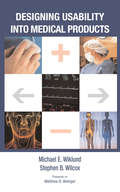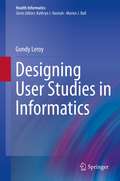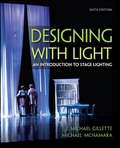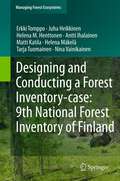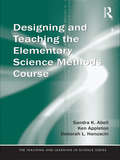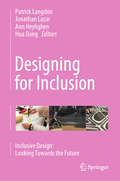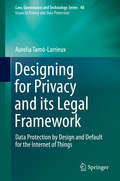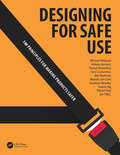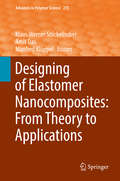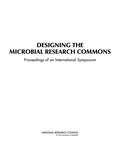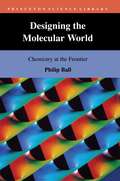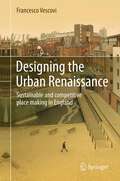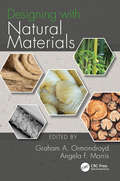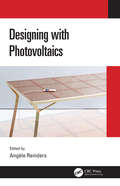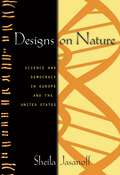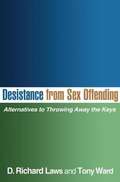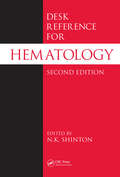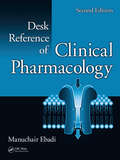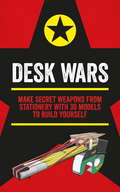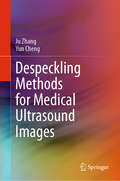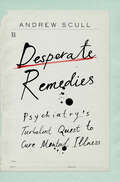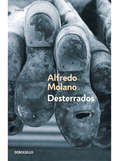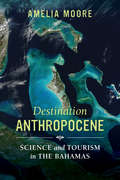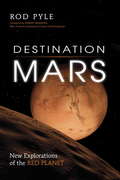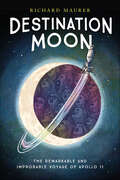- Table View
- List View
Designing Usability into Medical Products
by Michael E. Wiklund Stephen B. WilcoxAdvocating a user-centered approach to medical technology design, Designing Usability into Medical Products covers the essential processes and specific techniques necessary to produce safe, effective, usable, and appealing medical systems and products. Written by experts on user-centered research, design, and evaluation, the book provides a range o
Designing User Studies in Informatics
by Gondy LeroyThis book provides a practical, hands-on guide to conducting user studies in informatics. Its purpose is to explain the foundations of different experimental designs together with the appropriate statistical analyses for studies most often conducted in computing. Common mistakes are highlighted together with guidelines on how they should be avoided. The book is intended for advanced undergraduate students, beginning graduate students and as a refresher for any researcher evaluating the usefulness of informatics for people by doing user studies. With clear, non-technical language, fundamental concepts are explained and illustrated using diverse examples. In addition to the foundations, practical tips to starting, acquiring permission, recruiting participants, conducting and publishing studies are included. A how-to guide, in the form of a cookbook, is also included. The cookbook recipes can be followed step-by-step or adjusted as necessary for different studies. Each recipe contains step-by-step instructions and concrete advice.
Designing With Light: An Introduction To Stage Lighting
by J. Michael Gillette Michael McNamaraThe purpose of this book is to introduce students to stage lighting design, which is an amalgam of technology and art. Without an understanding of the technology used in the craft, it is difficult to design with light.
Designing and Conducting a Forest Inventory - case: 9th National Forest Inventory of Finland
by Matti Katila Juha Heikkinen Helena M. Henttonen Tarja Tuomainen Nina Vainikainen Antti Ihalainen Helena Mäkelä Erkki TomppoThis book demonstrates in detail all phases of the 9th National Forest Inventory of Finland (1996-2003): the planning of the sampling design, measurements, estimation methods and results. The inventory knowledge accumulated during almost one hundred years is consolidated in the book. The purpose of the numerous examples of results is to demonstrate the diversity of the estimates and content of a national forest inventory. The most recent results include the assessment of the indicators describing the biodiversity of forests. The Finnish NFI has been and is a model for many countries worldwide. The methods and results of the book are set in the international context and are applicable globally. The book provides a valuable information source for countries, institutions and researchers planning own inventories as well as modifying the existing ones, or seeking the applicable definitions and estimation methods to use in their own inventories.
Designing and Teaching the Elementary Science Methods Course (Teaching and Learning in Science Series)
by Ken Appleton Sandra K. Abell Deborah L. HanuscinWhat do aspiring and practicing elementary science teacher education faculty need to know as they plan and carry out instruction for future elementary science teachers? This scholarly and practical guide for science teacher educators outlines the theory, principles, and strategies needed, and provides classroom examples anchored to those principles. The theoretical and empirical foundations are supported by scholarship in the field, and the practical examples are derived from activities, lessons, and units field-tested in the authors’ elementary science methods courses. Designing and Teaching the Elementary Science Methods Course is grounded in the theoretical framework of pedagogical content knowledge (PCK), which describes how teachers transform subject matter knowledge into viable instruction in their discipline. Chapters on science methods students as learners, the science methods course curriculum, instructional strategies, methods course assessment, and the field experience help readers develop their PCK for teaching prospective elementary science teachers. "Activities that Work" and "Tools for Teaching the Methods Course" provide useful examples for putting this knowledge into action in the elementary science methods course.
Designing for Inclusion: Inclusive Design: Looking Towards The Future
by Jonathan Lazar Patrick Langdon Ann Heylighen Hua DongThis proceedings book presents papers from the 10th Cambridge Workshops on Universal Access and Assistive Technology. The CWUAAT series of workshops have celebrated a long history of interdisciplinarity, including design disciplines, computer scientists, engineers, architects, ergonomists, ethnographers, ethicists, policymakers, practitioners, and user communities. This reflects the wider increasing realisation over the long duration of the series that design for inclusion is not limited to technology, engineering disciplines, and computer science but instead requires an interdisciplinary approach. The key to this is providing a platform upon which the different disciplines can engage and see each other’s antecedents, methods, and point of view. This proceedings book of the 10th CWUAAT conference presents papers in a variety of topics including: * Reconciling usability, accessibility, and inclusive design; * Designing inclusive assistive and rehabilitation systems; * Designing cognitive interaction with emerging technologies; * Designing inclusive architecture; * Data mining and visualising inclusion; * Legislation, standards, and policy in inclusive design; * Situational inclusive interfaces; and * The historical perspective: 20 years of CWUAAT. CWUAAT has always aimed to be inclusive in the fields that it invites to the workshop. We must include social science, psychologies, anthropologies, economists, politics, governance, and business. This requirement is now energised by imminent new challenges arising from techno-social change. In particular, artificial intelligence, wireless technologies, and the Internet of Things generate a pressing need for more socially integrated projects with operational consequences on individuals in the built environment and at all levels of design and society. Business cases and urgent environmental issues such as sustainability and transportation should now be a focus point for inclusion in an increasingly challenging world. This proceedings book continues the goal of designing for inclusion, as set out by the CWUAAT when it first started.
Designing for Privacy and its Legal Framework
by Aurelia Tamò-LarrieuxThis book discusses the implementation of privacy by design in Europe, a principle that has been codified within the European Data Protection Regulation (GDPR). While privacy by design inspires hope for future privacy-sensitive designs, it also introduces the need for a common understanding of the legal and technical concepts of privacy and data protection. By pursuing an interdisciplinary approach and comparing the problem definitions and objectives of both disciplines, this book bridges the gap between the legal and technical fields in order to enhance the regulatory and academic discourse. The research presented reveals the scope of legal principles and technical tools for privacy protection, and shows that the concept of privacy by design goes beyond the principle of the GDPR. The book presents an analysis of how current regulations delegate the implementation of technical privacy and data protection measures to developers and describes how policy design must evolve in order to implement privacy by design and default principles.
Designing for Safe Use: 100 Principles for Making Products Safer
by Jonathan Kendler Michael Wiklund Jon Tilliss Cory Costantino Kimmy Ansems Valerie Ng Ruben Post Rachel Aronchick Alix Dorfman Brenda Van GeelHow do you prevent a critical care nurse from accidentally delivering a morphine overdose to an ill patient? Or ensure that people don't insert their arm into a hydraulic mulcher? And what about enabling trapped airline passengers to escape safely in an emergency? <P><P>Product designers and engineers face myriad such questions every day. Failure to answer them correctly can result in product designs that lead to injury or even death due to use error. Historically, designers and engineers have searched for answers by sifting through complicated safety standards or obscure industry guidance documents. <P><P>Designing for Safe Use is the first comprehensive source of safety-focused design principles for product developers working in any industry. <P><P>Inside you’ll find 100 principles that help ensure safe interactions with products as varied as baby strollers, stepladders, chainsaws, automobiles, apps, medication packaging, and even airliners. You’ll discover how protective features such as blade guards, roll bars, confirmation screens, antimicrobial coatings, and functional groupings can protect against a wide range of dangerous hazards, including sharp edges that can lacerate, top-heavy items that can roll over and crush, fumes that can poison, and small parts that can pose a choking hazard. <P><P>Special book features include: <li>Concise, illustrated descriptions of design principles <li>Sample product designs that illustrate the book’s guidelines and exemplify best practices <li>Literature references for readers interested in learning more about specific hazards and protective measures <li>Statistics on the number of injuries that have arisen in the past due to causes that might be eliminated by applying the principles in the book <P><P>Despite its serious subject matter, the book’s friendly tone, surprising anecdotes, bold visuals, and occasional attempts at dry humor will keep you interested in the art and science of making products safer. Whether you read the book cover-to-cover or jump around, the book’s relatable and practical approach will help you learn a lot about making products safe. <P><P>Designing for Safe Use is a primer that will spark in readers a strong appreciation for the need to design safety into products. This reference is for designers, engineers, and students who seek a broad knowledge of safe design solutions. .
Designing of Elastomer Nanocomposites: From Theory to Applications
by Klaus Werner Stöckelhuber Amit Das Manfred KlüppelThe series Advances in Polymer Science presents critical reviews of the present and future trends in polymer and biopolymer science. It covers all areas of research in polymer and biopolymer science including chemistry, physical chemistry, physics, material science. The thematic volumes are addressed to scientists, whether at universities or in industry, who wish to keep abreast of the important advances in the covered topics. Advances in Polymer Science enjoys a longstanding tradition and good reputation in its community. Each volume is dedicated to a current topic, and each review critically surveys one aspect of that topic, to place it within the context of the volume. The volumes typically summarize the significant developments of the last 5 to 10 years and discuss them critically, presenting selected examples, explaining and illustrating the important principles, and bringing together many important references of primary literature. On that basis, future research directions in the area can be discussed. Advances in Polymer Science volumes thus are important references for every polymer scientist, as well as for other scientists interested in polymer science - as an introduction to a neighboring field, or as a compilation of detailed information for the specialist. Review articles for the individual volumes are invited by the volume editors. Single contributions can be specially commissioned. Readership: Polymer scientists, or& scientists in related fields interested in polymer and biopolymer science, at universities or in industry, graduate students.
Designing the Microbial Research Commons
by The National Academy of SciencesRecent decades have witnessed an ever-increasing range and volume of digital data. All elements of the pillars of science--whether observation, experiment, or theory and modeling--are being transformed by the continuous cycle of generation, dissemination, and use of factual information. This is even more so in terms of the re-using and re-purposing of digital scientific data beyond the original intent of the data collectors, often with dramatic results. We all know about the potential benefits and impacts of digital data, but we are also aware of the barriers, the challenges in maximizing the access, and use of such data. There is thus a need to think about how a data infrastructure can enhance capabilities for finding, using, and integrating information to accelerate discovery and innovation. How can we best implement an accessible, interoperable digital environment so that the data can be repeatedly used by a wide variety of users in different settings and with different applications? With this objective: to use the microbial communities and microbial data, literature, and the research materials themselves as a test case, the Board on Research Data and Information held an International Symposium on Designing the Microbial Research Commons at the National Academy of Sciences in Washington, DC on 8-9 October 2009. The symposium addressed topics such as models to lower the transaction costs and support access to and use of microbiological materials and digital resources from the perspective of publicly funded research, public-private interactions, and developing country concerns. The overall goal of the symposium was to stimulate more research and implementation of improved legal and institutional models for publicly funded research in microbiology.
Designing the Molecular World: Chemistry at the Frontier (Princeton Science Library #117)
by Philip BallSome of the most exciting scientific developments in recent years have come not from theoretical physicists, astronomers, or molecular biologists but instead from the chemistry lab. Chemists have created superconducting ceramics for brain scanners, designed liquid crystal flat screens for televisions and watch displays, and made fabrics that change color while you wear them. They have fashioned metals from plastics, drugs from crude oil, and have pinpointed the chemical pollutants affecting our atmosphere and are now searching for remedies for the imperiled planet. <P><P>Philip Ball, an editor for the prestigious magazine Nature, lets the lay reader into the world of modern chemistry. Here, for example, chemists find new uses for the improbable buckminsterfullerene molecules--60-atom carbon soccerballs, dubbed "buckyballs"--which seem to have applications for everything from lubrication to medicine to electronics. The book is not intended as an introduction to chemistry, but as an accessible survey of recent developments throughout many of the major fields allied with chemistry: from research in traditional areas such as crystallography and spectroscopy to entirely new fields of study such as molecular electronics, artificial enzymes, and "smart" polymer gels. Ball's grand tour along the leading edge of scientific discovery will appeal to all curious readers, with or without any scientific training, to chemistry students looking for future careers, and to practicing chemical researchers looking for information on other specialties within their discipline.
Designing the Urban Renaissance: Sustainable and competitive place making in England
by Francesco VescoviThis book is an academic essay about the urban regeneration policies which have been changing the physical - and partly social - outlook of many English cities during the last 10-15 years, eventually giving birth to a process which is also known as 'Urban Renaissance'. The main focus is on urban design: the way it has been promoted by the government as an important means for delivering attractive places in more sustainable and competitive cities. The research describes the support given to local authorities for this purpose through new laws and powers, the publishing of planning and design manuals and the delivery of especially dedicated funds, bodies and programmes. It also explores the character and purpose of new developments such as scientific parks, creative/cultural quarters, retail and commercial dis-tricts, public realm works, describing recurring design rules and features. Readers interested in urban policies, architecture and the built environment will find a concise yet comprehensive explanation, enriched by more than a hundred pictures, on why and how many towns and cities like Birmingham, Nottingham, Leicester or Sheffield have been changing during the last decade.
Designing with Natural Materials
by Graham A. Ormondroyd Angela F. MorrisIn a world now forced to address the issues of sustainability, environmental impact, and the widespread pollution of land and oceans with manmade materials, alternative resources must be considered for the future of the planet. A vast array of natural materials is available throughout the world with properties that are often superior to the man-made alternatives. Designing with Natural Materials fills the gap between the current scientific knowledge of the use of natural materials and product design and acts as a bridge between the two disciplines. The book serves as an introduction to natural materials within the context of design. The chapters include case studies, research, and a historical perspective. It develops ideas of designing with natural materials in specific areas and looks to the future of new biobased materials and how these will influence design. The work offers insight to designers of biobased materials across a range of different design disciplines while also providing insights to scientists on the process of design, production, and the needs of a material beyond those traditionally analyzed in the laboratory. The final chapters touch on the use of bioinspiration and biomimicry in the development and use of biobased materials and how natural design will influence both material design and products in the future. The book will be of interest to engineers, scientific researchers, professional designers, students, those working in industry who are considering using natural materials as an alternative to current unsustainable options, and anyone who has an interest in the subject.
Designing with Photovoltaics
by Angèle Reinders"Designing with Photovoltaics" cover a broad range of topics related to the design of products, buildings and vehicles with integrated photovoltaic (PV) technologies including storage aspect. It enables the reader to easily design new products, buildings and vehicles through use of innovative PV products. Diverse categories of product integrated PVs are discussed including applications of solar power for mobility and building integrated systems along with design- and manufacturing-related information about solar cells. Illustrating design cases of various PV-powered products, special attention is paid to end-users and environmental aspects of PV applications. Aimed at senior undergraduates, graduates and professionals in electrical engineering, architecture, design, physics, mechanical engineering and those specifically studying photovoltaics, it Covers the different product integrated photovoltaics (PIPV) with a focus on design and manufacturing Presents comprehensive overview of all aspects of designing with photovoltaics Includes product integrated PV, building integrated PV and solar powered mobility concepts Contains real design cases showing how to design with photovoltaics Discusses context of environmental issues and user aspects
Designs on Nature: Science and Democracy in Europe and the United States
by Sheila JasanoffBiology and politics have converged today across much of the industrialized world. Debates about genetically modified organisms, cloning, stem cells, animal patenting, and new reproductive technologies crowd media headlines and policy agendas. Less noticed, but no less important, are the rifts that have appeared among leading Western nations about the right way to govern innovation in genetics and biotechnology. These significant differences in law and policy, and in ethical analysis, may in a globalizing world act as obstacles to free trade, scientific inquiry, and shared understandings of human dignity. In this magisterial look at some twenty-five years of scientific and social development, Sheila Jasanoff compares the politics and policy of the life sciences in Britain, Germany, the United States, and in the European Union as a whole. She shows how public and private actors in each setting evaluated new manifestations of biotechnology and tried to reassure themselves about their safety. Three main themes emerge. First, core concepts of democratic theory, such as citizenship, deliberation, and accountability, cannot be understood satisfactorily without taking on board the politics of science and technology. Second, in all three countries, policies for the life sciences have been incorporated into "nation-building" projects that seek to reimagine what the nation stands for. Third, political culture influences democratic politics, and it works through the institutionalized ways in which citizens understand and evaluate public knowledge. These three aspects of contemporary politics, Jasanoff argues, help account not only for policy divergences but also for the perceived legitimacy of state actions.
Desistance from Sex Offending
by D. Richard Laws Tony WardThis book offers a fresh perspective on treating a population that is often demonized by policymakers, the public, and even clinicians. The authors argue that most sex offenders are "people like us," with the potential to lead meaningful, law-abiding lives if given a chance and appropriate support. They describe an empirically and theoretically grounded rehabilitation approach, the Good Lives Model, which can be integrated with the assessment and intervention approaches that clinicians already use. Drawing on the latest knowledge about factors promoting desistance from crime, the book discusses how encouraging naturally occurring desistance processes, and directly addressing barriers to community reintegration, can make treatment more effective and long lasting.
Desk Reference for Hematology
by N. K ShintonA cross between a dictionary and an encyclopedia, Desk Reference for Hematology, Second Edition presents a concise yet thorough examination of hematology and its relationship with other systems and disorders. The 1500 alphabetically listed articles provide quick and easy access to expert information, the 150 tables put precise data at your f
Desk Reference of Clinical Pharmacology
by Manuchair EbadiSince the publication of the bestselling first edition of CRC Desk Reference of Clinical Pharmacology, dramatic discoveries in molecular medicine along with rapid technological advances have revolutionized the diagnosis and resulted in new medications to be used in the treatment of a broad range of human diseases. To stay abreast of these ra
Desk Wars: Make secret weapons from stationery with 30 models to build yourself (Mini Weapons of Mass Destruction)
by John Austin'Cubicle farms are full of enemy combatants begging to be taken out.' WIREDAchieve clandestine ends practically and inexpensively with Desk Wars - perfect for do-it-yourself spy enthusiasts. Follow fully illustrated step-by-step instructions to build 30 miniature secret weapons and surveillance tools from stationery, transforming common household items into uncommon gadgets and sidearms.Assert dominion over the desktop with these cunning contraptions:>>> Paper-Dart Watch>>> Pen Blowgun>>> Mint-Tin Catapult>>> Rubber-Band Derringer>>> Toothpaste Periscope>>> Bionic Ear>>> Cotton Bud .38 Special>>> Paper Throwing Star>>> 44 marker magnum>>> And more!
Despeckling Methods for Medical Ultrasound Images
by Ju Zhang Yun ChengBased upon the research they have conducted over the past decade in the field of denoising processes for medical ultrasonic imaging, in this book, the authors systematically present despeckling methods for medical ultrasonic images. Firstly, the respective methods are reviewed and divided into five categories. Secondly, after introducing some basic mathematical tools such as wavelet and shearlet transforms, the authors highlight five recently developed despeckling methods for medical ultrasonic images. In turn, simulations and experiments for clinical ultrasonic images are presented for each method, and comparison studies with other well-known existing methods are conducted, showing the effectiveness and superiority of the new methods. Students and researchers in the field of signal and image processing, as well as medical professionals whose work involves ultrasonic diagnosis, will greatly benefit from this book. Familiarizing them with the state of the art in despeckling methods for medical ultrasonic images, it offers a useful reference guide for their study and research work.
Desperate Remedies: Psychiatry’s Turbulent Quest to Cure Mental Illness
by Andrew ScullA sweeping history of American psychiatry—from prisons to hospitals to the lab to the analyst’s couch—by the award-winning author of Madness in Civilization. For more than two hundred years, disturbances of the mind—the sorts of things that were once called “madness”—have been studied and treated by the medical profession. Mental illness, some insist, is a disease like any other, whose origins can be identified and from which one can be cured. But is this true? In this masterful account of America’s quest to understand and treat everything from anxiety to psychosis, one of the most provocative thinkers writing about psychiatry today sheds light on its tumultuous past. Desperate Remedies brings together a galaxy of mind doctors working in and out of institutional settings: psychologists and psychoanalysts, neuroscientists, and cognitive behavioral therapists, social reformers and advocates of mental hygiene, as well as patients and their families desperate for relief. Andrew Scull begins with the birth of the asylum in the reformist zeal of the 1830s and carries us through to the latest drug trials and genetic studies. He carefully reconstructs the rise and fall of state-run mental hospitals to explain why so many of the mentally ill are now on the street and why so many of those whose bodies were experimented on were women. In his compelling closing chapters, he reveals how drug companies expanded their reach to treat a growing catalog of ills, leading to an epidemic of over-prescribing while deliberately concealing debilitating side effects. Carefully researched and compulsively readable, Desperate Remedies is a definitive account of America’s long battle with mental illness that challenges us to rethink our deepest assumptions about who we are and how we think and feel.
Desterrados
by Bravo Alfredo Molano«Cuando mataron a Jaime Garzón admití que no podía regresar pronto, conseguí una mesa de trabajo grande, alé la pluma y comencé a escribir este libro. Al terminarlo comprendí agachando la cabeza en señal de profundo respeto que el drama de mi exilio, a pesar de sus dolores, es un pálido reflejo de la auténtica tragedia que viven a diario millones de colombianos desterrados, exiliados en su propio país. Creo, con ellos, que sólo un acuerdo político profundo permitirá echar las bases de una verdadera democracia; la guerra no tendría resultado distinto a la dictadura de los vencedores».Alfredo Molano
Destination Anthropocene: Science and Tourism in The Bahamas (Critical Environments: Nature, Science, and Politics #7)
by Amelia MooreDestination Anthropocene documents the emergence of new travel imaginaries forged at the intersection of the natural sciences and the tourism industry in a Caribbean archipelago. Known to travelers as a paradise of sun, sand, and sea, The Bahamas is rebranding itself in response to the rising threat of global environmental change, including climate change. In her imaginative new book, Amelia Moore explores an experimental form of tourism developed in the name of sustainability, one that is slowly changing the way both tourists and Bahamians come to know themselves and relate to island worlds.
Destination Mars
by Rod Pyle Robert ManningIn the next decade, NASA, by itself and in collaboration with the European Space Agency, is planning a minimum of four separate missions to Mars. Clearly, exciting times are ahead for Mars exploration. This is an insider's look into the amazing projects now being developed here and abroad to visit the legendary red planet. <P><P> Drawing on his contacts at NASA and the Jet Propulsion Laboratory, the author provides stunning insights into the history of Mars exploration and the difficulties and dangers of traveling there. After an entertaining survey of the human fascination with Mars over the centuries, the author offers an introduction to the geography, geology, and water processes of the planet. He then briefly describes the many successful missions by NASA and others to that distant world. But failure and frustration also get their due. <P><P>As the author makes clear, going to Mars is not, and never will be, easy. Later in the book, he describes in detail what each upcoming mission will involve. In the second half of the book, he offers the reader a glimpse inside the world of Earth-based "Mars analogs," places on Earth where scientists are conducting research in hostile environments that are eerily "Martian." <P><P>Finally, he constructs a probable scenario of a crewed expedition to Mars, so that readers can see how earlier robotic missions and human Earth simulations will fit together. All this is punctuated by numerous firsthand interviews with some of the finest Mars explorers of our day, including Stephen Squyres (Mars Exploration Rover), Bruce Murray (former director of the Jet Propulsion Laboratory), and Peter Smith (chief of the Mars Phoenix Lander and the upcoming OSIRIS-REx missions). <P><P>These stellar individuals give us an insider's view of the difficulties and rewards of roaming the red planet. The author's infectious enthusiasm and firsthand knowledge of the international space industry combine to make a uniquely appealing and accessible book about Mars.From the Trade Paperback edition.
Destination Moon: The Remarkable and Improbable Voyage of Apollo 11
by Richard MaurerThe history of NASA's Apollo program from Earth orbital missions to lunar landings in a propulsive nonfiction narrative.Only now, it is becoming clear how exceptional and unrepeatable Apollo was. At its height, it employed almost half a million people, many working seven days a week and each determined that “it will not fail because of me.”Beginning with fighter pilots in World War II, Maurer traces the origins of the Apollo program to a few exceptional soldiers, a Nazi engineer, and a young eager man who would become president.Packed with adventure, new stories about familiar people, and undeniable danger, Destination Moon takes an unflinching look at a tumultuous time in American history, told expertly by nonfiction author Richard Maurer.
